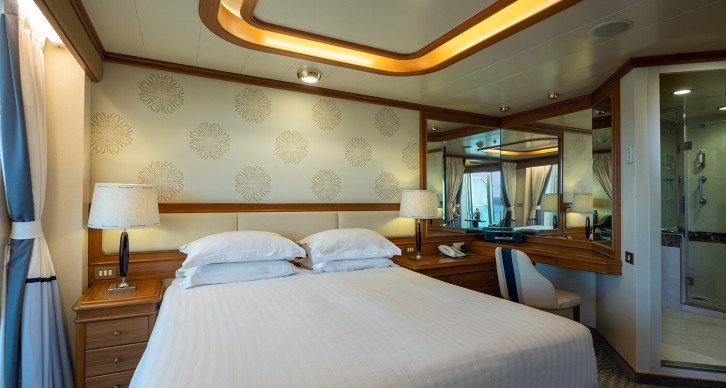(Prices correct as of today’s date, are updated daily, are subject to change and represent genuine availability at time of update).
Cruise only holidays are financially protected by ABTA. Fly cruise holidays are financially protected by P&O Cruises under ATOL number 6294
Please click here to check the essential travel requirements before booking this cruise.
Want to add a hotel stay or change your flights?
Just call our team of cruise specialists to help build your dream cruise holiday today!
Prices based on 2 people sharing. Cruise only price does not include flights. Fly-cruise price may vary by chosen UK airport.
Itinerary

Valletta
Malta's capital, the minicity of Valletta, has ornate palaces and museums protected by massive fortifications of honey-color limestone. Houses along the narrow streets have overhanging wooden balconies for people-watching from indoors. Generations ago they gave housebound women a window on... Read More
Valletta
At Sea
Civitavecchia
Livorno
Ajaccio, Corsica
At Sea
Messina
Valletta
At Sea
Santorini
Piraeus
Suda Bay, Crete
Kusadasi
At Sea
Valletta
What's Included with
P&O Cruises
Accommodation
Breakfast, lunch, dinner and snacks in a choice of included dining venues
Entertainment throughout the day and evening
Use of swimming pools, hot tubs, fitness centre and leisure facilities where available
Complimentary shuttle service from ship to port where available
Port taxes
Themed events and discos
Tea and coffee in seleted venues
Porterage of luggage from port to cabin
Youth programmes for 2-17 year olds
Free of charge babysitting from 6 months - 4 years of age. Daily from 6pm to 2am
Explore Azura
Meridian Restaurant
Freedom Dining at the Meridian Restaurant. Like to escape the usual routine on holiday? Then you’ll love the flexibility of Freedom Dining. Opt for an early dinner one night and a late supper the next; you can shape each day as you please.
SeaScreen Open Air Cinema
Imagine watching a film under a starry, night sky, while you're being magically transported to another new destination. SeaScreen is one of the most exciting features on board Azura because it's more than just a pool – it's an open-air cinema as well! The giant screen sitting proudly above the beautifully designed pool area will show a variety of classic films, family favourites and the latest blockbusters.
Gymnasium
It’s easy to keep active on Azura. Work out in her gym, take a spinning class, or a nice walk around deck. They offer a range of fitness classes such as indoor cycling, pilates, yoga, body sculpt boot camp and push 'n' lift which are assisted by a fitness instructor.
The gym is typically open from 8am - 8pm every day and use of the on board gym equipment is complimentary: Equipment on board includes:
- Bikes
- Treadmills
- Cross-trainers
- Steppers
- Rowing machines
- Free weights
The below classes are charged at an additional cost of approximately £7 per person per class and can be booked on board:
- Pilates
- Yoga
- Tour de Cycle group cycling
- Body sculpt boot camp
- TRX and results based training
The Reef
- Rock up to The Reef! With age-specific clubs, a night nursery, a boatload of activities and enthusiastic Reef Rangers on hand, The Reef is the place to be for under 18s. Split into four age groups, there are a whole host of exciting activities organised daily by our enthusiastic and well qualified Reef Rangers, to keep children of all ages entertained safely throughout the day and evening
Sky Deck

- Golf Nets
- Sports Court
Ocean Deck

- Planet Bar
Sun Deck

- The Retreat
- The Epicurean Restaurant
Aqua Deck

- Oasis Spa
- Gymnasium
- Oasis Pool
- Whirlpool Spa
- Salon
- Treatment Rooms
- Ivory Suite
- Breakers Bar
- Sea Screen
- Shuffleboard
- The Hub (The Reef)
- Apartment 16 (The Reef)
- The Sea Bed
- Game On
- The Beach Hut (The Reef)
- Frontiers (The Reef)
Lido Deck

- Thermal Suite
- Coral Bar
- Poolside Grill
- Whirlpool Spa
- Coral Pool
- Poolside Pizza & Ice Cream
- Aqua Pool
- Aqua Bar
- Venezia
- Verona
- Terrace Bar
- Beach House
- Inside Cabins
- Balcony Cabins
- Outside Staterooms
- Suites
A Deck

- Penthouse Suites
- Suites
- Balcony Cabins
- Inside Cabins
Riviera Deck

- Suites
- Balcony Cabins
- Inside Cabins
- Terrace Pool
B Deck

- Balcony Cabins
- Inside Cabins
C Deck

- Suites
- Balcony Cabins
- Inside Cabins
D Deck

- Suites
- Superior Deluxe Cabins
- Balcony Cabins
- Inside Cabins
E Deck

- Suites
- Superior Deluxe Balcony Cabins
- Balcony Cabins
- Outside Cabins
- Inside Cabins
Prom Deck

- The Playhouse
- The Glass House
- Shopping
- The Blue Bar
- Atrium
- Shopping
- Malabar
- Sindhu
- Photo Gallery
- Manhattan
F Deck

- Single Outside Cabins
- Single Inside Cabins
- The Playhouse
- The Karmala Room
- Casino
- Brodie's Bar
- Shopping
- Reception
- Atrium
- The Peninsular Restaurant
- The Oriental Restaurant
P Deck

- Outside Cabins
- Inside Cabins
- Launderette
- The Gallery
- Java
- Shopping
- Explorers
- Atrium
- The Library
- The Meridian Restaurant
Azura Cabins & Suites

Inside Cabin


Single Cabin

Balcony Cabin







-large_thumb.jpg)









